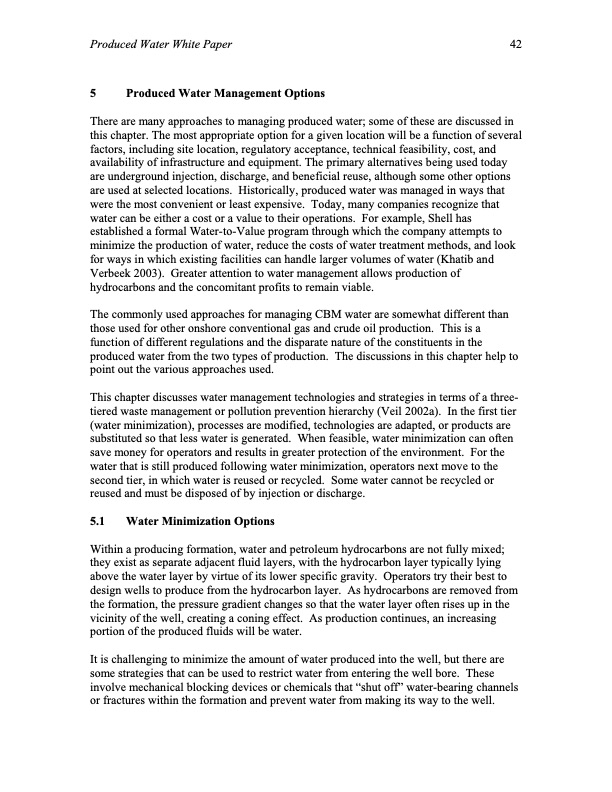
PDF Publication Title:
Text from PDF Page: 050
Produced Water White Paper 42 5 Produced Water Management Options There are many approaches to managing produced water; some of these are discussed in this chapter. The most appropriate option for a given location will be a function of several factors, including site location, regulatory acceptance, technical feasibility, cost, and availability of infrastructure and equipment. The primary alternatives being used today are underground injection, discharge, and beneficial reuse, although some other options are used at selected locations. Historically, produced water was managed in ways that were the most convenient or least expensive. Today, many companies recognize that water can be either a cost or a value to their operations. For example, Shell has established a formal Water-to-Value program through which the company attempts to minimize the production of water, reduce the costs of water treatment methods, and look for ways in which existing facilities can handle larger volumes of water (Khatib and Verbeek 2003). Greater attention to water management allows production of hydrocarbons and the concomitant profits to remain viable. The commonly used approaches for managing CBM water are somewhat different than those used for other onshore conventional gas and crude oil production. This is a function of different regulations and the disparate nature of the constituents in the produced water from the two types of production. The discussions in this chapter help to point out the various approaches used. This chapter discusses water management technologies and strategies in terms of a three- tiered waste management or pollution prevention hierarchy (Veil 2002a). In the first tier (water minimization), processes are modified, technologies are adapted, or products are substituted so that less water is generated. When feasible, water minimization can often save money for operators and results in greater protection of the environment. For the water that is still produced following water minimization, operators next move to the second tier, in which water is reused or recycled. Some water cannot be recycled or reused and must be disposed of by injection or discharge. 5.1 Water Minimization Options Within a producing formation, water and petroleum hydrocarbons are not fully mixed; they exist as separate adjacent fluid layers, with the hydrocarbon layer typically lying above the water layer by virtue of its lower specific gravity. Operators try their best to design wells to produce from the hydrocarbon layer. As hydrocarbons are removed from the formation, the pressure gradient changes so that the water layer often rises up in the vicinity of the well, creating a coning effect. As production continues, an increasing portion of the produced fluids will be water. It is challenging to minimize the amount of water produced into the well, but there are some strategies that can be used to restrict water from entering the well bore. These involve mechanical blocking devices or chemicals that “shut off” water-bearing channels or fractures within the formation and prevent water from making its way to the well.PDF Image | Produced Water from Production of Crude Oil

PDF Search Title:
Produced Water from Production of Crude OilOriginal File Name Searched:
ProducedWatersWP0401.pdfDIY PDF Search: Google It | Yahoo | Bing
NFT (Non Fungible Token): Buy our tech, design, development or system NFT and become part of our tech NFT network... More Info
IT XR Project Redstone NFT Available for Sale: NFT for high tech turbine design with one part 3D printed counter-rotating energy turbine. Be part of the future with this NFT. Can be bought and sold but only one design NFT exists. Royalties go to the developer (Infinity) to keep enhancing design and applications... More Info
Infinity Turbine IT XR Project Redstone Design: NFT for sale... NFT for high tech turbine design with one part 3D printed counter-rotating energy turbine. Includes all rights to this turbine design, including license for Fluid Handling Block I and II for the turbine assembly and housing. The NFT includes the blueprints (cad/cam), revenue streams, and all future development of the IT XR Project Redstone... More Info
Infinity Turbine ROT Radial Outflow Turbine 24 Design and Worldwide Rights: NFT for sale... NFT for the ROT 24 energy turbine. Be part of the future with this NFT. This design can be bought and sold but only one design NFT exists. You may manufacture the unit, or get the revenues from its sale from Infinity Turbine. Royalties go to the developer (Infinity) to keep enhancing design and applications... More Info
Infinity Supercritical CO2 10 Liter Extractor Design and Worldwide Rights: The Infinity Supercritical 10L CO2 extractor is for botanical oil extraction, which is rich in terpenes and can produce shelf ready full spectrum oil. With over 5 years of development, this industry leader mature extractor machine has been sold since 2015 and is part of many profitable businesses. The process can also be used for electrowinning, e-waste recycling, and lithium battery recycling, gold mining electronic wastes, precious metals. CO2 can also be used in a reverse fuel cell with nafion to make a gas-to-liquids fuel, such as methanol, ethanol and butanol or ethylene. Supercritical CO2 has also been used for treating nafion to make it more effective catalyst. This NFT is for the purchase of worldwide rights which includes the design. More Info
NFT (Non Fungible Token): Buy our tech, design, development or system NFT and become part of our tech NFT network... More Info
Infinity Turbine Products: Special for this month, any plans are $10,000 for complete Cad/Cam blueprints. License is for one build. Try before you buy a production license. May pay by Bitcoin or other Crypto. Products Page... More Info
| CONTACT TEL: 608-238-6001 Email: greg@infinityturbine.com | RSS | AMP |